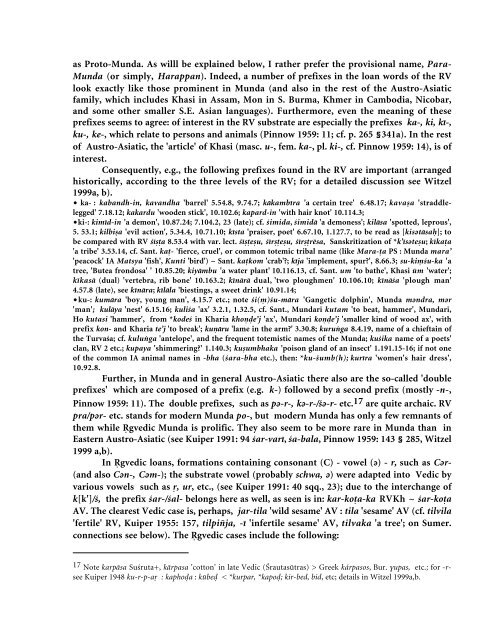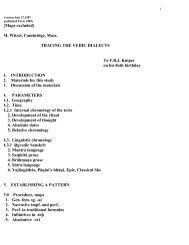The Languages of Harappa - People Fas Harvard
The Languages of Harappa - People Fas Harvard
The Languages of Harappa - People Fas Harvard
Create successful ePaper yourself
Turn your PDF publications into a flip-book with our unique Google optimized e-Paper software.
as Proto-Munda. As willl be explained below, I rather prefer the provisional name, Para-<br />
Munda (or simply, <strong>Harappa</strong>n). Indeed, a number <strong>of</strong> prefixes in the loan words <strong>of</strong> the RV<br />
look exactly like those prominent in Munda (and also in the rest <strong>of</strong> the Austro-Asiatic<br />
family, which includes Khasi in Assam, Mon in S. Burma, Khmer in Cambodia, Nicobar,<br />
and some other smaller S.E. Asian languages). Furthermore, even the meaning <strong>of</strong> these<br />
prefixes seems to agree: <strong>of</strong> interest in the RV substrate are especially the prefixes ka-, ki, kī-,<br />
ku-, ke-, which relate to persons and animals (Pinnow 1959: 11; cf. p. 265 §341a). In the rest<br />
<strong>of</strong> Austro-Asiatic, the 'article' <strong>of</strong> Khasi (masc. u-, fem. ka-, pl. ki-, cf. Pinnow 1959: 14), is <strong>of</strong><br />
interest.<br />
Consequently, e.g., the following prefixes found in the RV are important (arranged<br />
historically, according to the three levels <strong>of</strong> the RV; for a detailed discussion see Witzel<br />
1999a, b).<br />
• ka- : kabandh-in, kavandha 'barrel' 5.54.8, 9.74.7; kåkambīra 'a certain tree' 6.48.17; kavaa 'straddlelegged'<br />
7.18.12; kakardu 'wooden stick', 10.102.6; kapard-in 'with hair knot' 10.114.3;<br />
•ki-: kimīd-in 'a demon', 10.87.24; 7.104.2, 23 (late); cf. śimida, śimidå 'a demoness'; kilåsa 'spotted, leprous',<br />
5. 53.1; kilbia 'evil action', 5.34.4, 10.71.10; kīsta 'praiser, poet' 6.67.10, 1.127.7, to be read as [kisətåsa]; to<br />
be compared with RV śīa 8.53.4 with var. lect. śīeu, śīreu, śīrrẽsa, Sanskritization <strong>of</strong> *k'īsəteu; kīkaa<br />
'a tribe' 3.53.14, cf. Sant. ka- 'fierce, cruel', or common totemic tribal name (like Mara-a PS : Munda mara’<br />
'peacock' IA Matsya 'fish', Kunti 'bird') ~ Sant. kakom 'crab'?; kīja 'implement, spur?', 8.66.3; su-kiśu-ka 'a<br />
tree, 'Butea frondosa' ' 10.85.20; kiyåmbu 'a water plant' 10.116.13, cf. Sant. um 'to bathe', Khasi ūm 'water';<br />
kīkaså (dual) 'vertebra, rib bone' 10.163.2; kīnårå dual, 'two ploughmen' 10.106.10; kīnåśa 'plough man'<br />
4.57.8 (late), see kīnåra; kīlåla 'biestings, a sweet drink' 10.91.14;<br />
•ku-: kumåra 'boy, young man', 4.15.7 etc.; note śi()śu-måra 'Gangetic dolphin', Munda məndra, mər<br />
'man'; kulåya 'nest' 6.15.16; kuliśa 'ax' 3.2.1, 1.32.5, cf. Sant., Mundari kutam 'to beat, hammer', Mundari,<br />
Ho kutasi 'hammer', from *kodeś in Kharia khoe’j 'ax', Mundari koe’j 'smaller kind <strong>of</strong> wood ax', with<br />
prefix kon- and Kharia te’j 'to break'; kuåru 'lame in the arm?' 3.30.8; kuruga 8.4.19, name <strong>of</strong> a chieftain <strong>of</strong><br />
the Turvaśa; cf. kuluga 'antelope', and the frequent totemistic names <strong>of</strong> the Munda; kuśika name <strong>of</strong> a poets'<br />
clan, RV 2 etc.; kupaya 'shimmering?' 1.140.3; kuumbhaka 'poison gland <strong>of</strong> an insect' 1.191.15-16; if not one<br />
<strong>of</strong> the common IA animal names in -bha (śara-bha etc.), then: *ku-šumb(h); kurīra 'women's hair dress',<br />
10.92.8.<br />
Further, in Munda and in general Austro-Asiatic there also are the so-called 'double<br />
prefixes' which are composed <strong>of</strong> a prefix (e.g. k-) followed by a second prefix (mostly -n-,<br />
Pinnow 1959: 11). <strong>The</strong> double prefixes, such as pə-r-, kə-r-/šə-r- etc. 17 are quite archaic. RV<br />
pra/pər- etc. stands for modern Munda po-, but modern Munda has only a few remnants <strong>of</strong><br />
them while gvedic Munda is prolific. <strong>The</strong>y also seem to be more rare in Munda than in<br />
Eastern Austro-Asiatic (see Kuiper 1991: 94 śar-varī, śa-bala, Pinnow 1959: 143 § 285, Witzel<br />
1999 a,b).<br />
In gvedic loans, formations containing consonant (C) - vowel (ə) - r, such as Cər-<br />
(and also Cən-, Cəm-); the substrate vowel (probably schwa, ə) were adapted into Vedic by<br />
various vowels such as , ur, etc., (see Kuiper 1991: 40 sqq., 23); due to the interchange <strong>of</strong><br />
k[k']/ś, the prefix śar-/śal- belongs here as well, as seen is in: kar-koa-ka RVKh ~ śar-koa<br />
AV. <strong>The</strong> clearest Vedic case is, perhaps, jar-tila 'wild sesame' AV : tila 'sesame' AV (cf. tilvila<br />
'fertile' RV, Kuiper 1955: 157, tilpiñja, -ī 'infertile sesame' AV, tilvaka 'a tree'; on Sumer.<br />
connections see below). <strong>The</strong> gvedic cases include the following:<br />
17 Note karpåsa Suśruta+, kårpasa 'cotton' in late Vedic (Śrautasūtras) > Greek kárpasos, Bur. γupas, etc.; for -rsee<br />
Kuiper 1948 ku-r-p-a : kaphoa : kūbe < *kurpar, *kapo; kir-bed, bid, etc; details in Witzel 1999a,b.

















